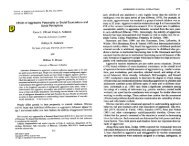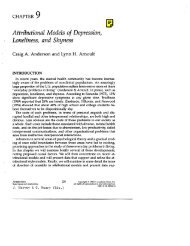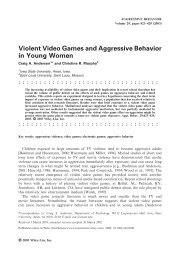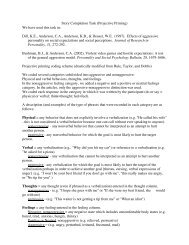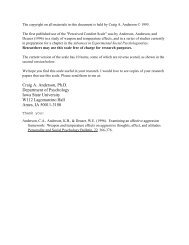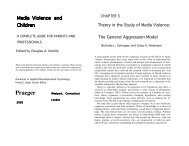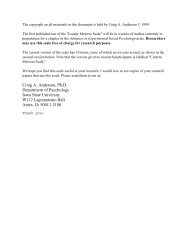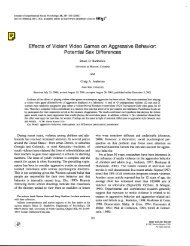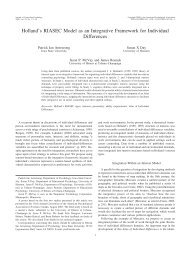The Effects of Violent Music on Children and Adolescents
The Effects of Violent Music on Children and Adolescents
The Effects of Violent Music on Children and Adolescents
You also want an ePaper? Increase the reach of your titles
YUMPU automatically turns print PDFs into web optimized ePapers that Google loves.
Name /mea_gentil_106027/106027_08/Mp_156 10/16/2003 02:46PM Plate # 0 pg 156 # 4<br />
156 Media Violence <strong>and</strong> <strong>Children</strong><br />
USES AND GRATIFICATIONS OF POPULAR MUSIC<br />
At the simplest, most global level, people <str<strong>on</strong>g>of</str<strong>on</strong>g> all ages listen to music because<br />
it provides pleasure. For adolescents especially, the pleasure can be intense<br />
<strong>and</strong> tends to be associated with the most intense, “peak” experiences <str<strong>on</strong>g>of</str<strong>on</strong>g> life.<br />
Lull (1992, p. 1) has stated, “<str<strong>on</strong>g>Music</str<strong>on</strong>g> promotes experiences <str<strong>on</strong>g>of</str<strong>on</strong>g> the extreme for<br />
its makers <strong>and</strong> listeners, turning the perilous emoti<strong>on</strong>al edges, vulnerabilities,<br />
triumphs, celebrati<strong>on</strong>s, <strong>and</strong> antag<strong>on</strong>isms <str<strong>on</strong>g>of</str<strong>on</strong>g> life into hypnotic, reflective tempos<br />
that can be experienced privately or shared with others.” Given the importance<br />
<str<strong>on</strong>g>of</str<strong>on</strong>g> music <strong>and</strong> its central role in adolescence, it is clear that it has a<br />
number <str<strong>on</strong>g>of</str<strong>on</strong>g> important effects. Yet although there has been c<strong>on</strong>cern for decades<br />
about possible deleterious effects <str<strong>on</strong>g>of</str<strong>on</strong>g> popular music, for most children, the<br />
effects are not deleterious. While this chapter cannot describe in detail the<br />
uses <str<strong>on</strong>g>of</str<strong>on</strong>g> music, we will describe briefly three major uses: affective uses, social<br />
uses, <strong>and</strong> the uses <str<strong>on</strong>g>of</str<strong>on</strong>g> lyrics (for a detailed review, see Christens<strong>on</strong> & Roberts,<br />
1998). It also should be noted that the research <strong>on</strong> music videos appears to<br />
show different effects from music al<strong>on</strong>e; thus music videos will be discussed<br />
later in this chapter.<br />
Affective Uses<br />
<str<strong>on</strong>g>The</str<strong>on</strong>g> major difference between popular music <strong>and</strong> other media lies in music’s<br />
ability to enhance or modify mood. In a study <str<strong>on</strong>g>of</str<strong>on</strong>g> Swedish adolescents, Roe<br />
(1985) presented possible reas<strong>on</strong>s for listening to music <strong>and</strong> asked students to<br />
indicate how <str<strong>on</strong>g>of</str<strong>on</strong>g>ten each applied to their listening. Factor analyses revealed<br />
three general trends: (1) atmosphere creati<strong>on</strong> <strong>and</strong> mood c<strong>on</strong>trol, (2) silencefilling<br />
<strong>and</strong> passing the time, <strong>and</strong> (3) attenti<strong>on</strong> to lyrics. Of the three types <str<strong>on</strong>g>of</str<strong>on</strong>g><br />
uses, atmosphere creati<strong>on</strong> <strong>and</strong> mood c<strong>on</strong>trol emerged as the most important,<br />
with time-filling sec<strong>on</strong>d <strong>and</strong> attenti<strong>on</strong> to lyrics a distant third. Summarizing<br />
the research <strong>on</strong> adolescent uses <str<strong>on</strong>g>of</str<strong>on</strong>g> music, Christens<strong>on</strong> & Roberts (1998, p. 48)<br />
suggested a principle they labeled “the primacy <str<strong>on</strong>g>of</str<strong>on</strong>g> affect.” For most young<br />
people, music use is driven primarily by the motivati<strong>on</strong> to c<strong>on</strong>trol mood <strong>and</strong><br />
enhance emoti<strong>on</strong>al states. <str<strong>on</strong>g>Music</str<strong>on</strong>g>’s ability to communicate emoti<strong>on</strong> <strong>and</strong> influence<br />
mood has been widely noted. Even preschoolers <strong>and</strong> infants as young as<br />
eight m<strong>on</strong>ths can reliably discriminate “happy” <strong>and</strong> “sad” music (Gentile &<br />
Pick, under review; Gentile, Pick, Flom, & Campos, 1994; Gentile, Stoerzinger,<br />
Finney, & Pick, 1996; Sullivan, Gentile, & Pick, 1998). Studies <str<strong>on</strong>g>of</str<strong>on</strong>g> mood<br />
inducti<strong>on</strong> <str<strong>on</strong>g>of</str<strong>on</strong>g>ten use music in order to change people’s moods (e.g., Kenealy,<br />
1988; Pignatiello, Camp, Elder, & Rasar, 1989; Pignatiello, Camp, & Rasar,<br />
1986). Because <str<strong>on</strong>g>of</str<strong>on</strong>g> the affective efficacy <str<strong>on</strong>g>of</str<strong>on</strong>g> music, when adolescents want to be<br />
in a certain mood, when they seek reinforcement for a certain mood, when<br />
they feel l<strong>on</strong>ely, or when they seek distracti<strong>on</strong> from their troubles, music tends<br />
to be the medium <str<strong>on</strong>g>of</str<strong>on</strong>g> choice to accomplish the task.<br />
While both males <strong>and</strong> females report using music to affirm or manage their



